“Wonderful life at sea.” “Tranquility.” “Breathtaking landscape.”
This is how the 2017 Korea.net Honorary Reporters described Tongyeong in Gyeongsangnam-do Province.
Early in the morning on Dec. 27, a group of 11 honorary reporters hopped onto a bus bound for the port city. They are among the 149 honorary reporters from around the world who will be sharing their blog posts recording their experiences of Korea throughout 2017.
The select group of 11 bloggers had a chance to explore the city as they currently reside in Korea. They came from five countries — Germany, Brazil, Ghana, the Philippines and Korea. With the two-day trip, the 11 honorary reporters would tell their first stories in the beautiful city, just off the southern ocean.
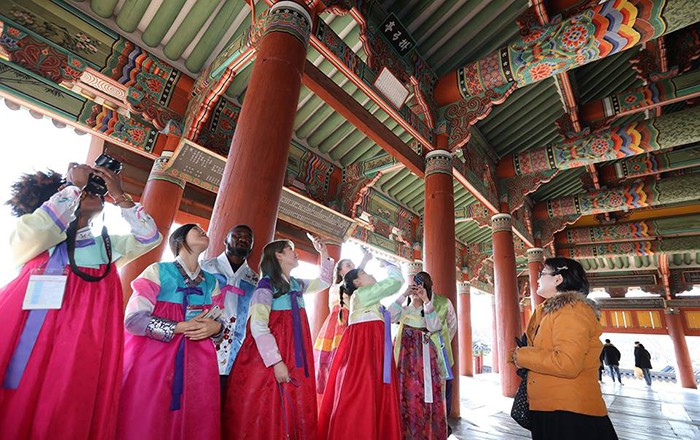
A group of 11 Korea.net Honorary Reporters admire the pillars and ceiling decorated with traditional patterns at Sebyeonggwan Hall, a Joseon-era building set up in honor of Admiral Yi Sun-shin.
The group ventured out to discover the city blessed with a picturesque blue sea and nearby islets, as well as find traces of great artists and historic figures, who grew up or achieved remarkable things in the city.
During the first leg of their itinerary, they reached Sebyeonggwan Hall (세병관) in Munhwa-dong, a wooden building built in 1603 during the Joseon era. The ancient building is dedicated to Admiral Yi Sun-shin (1545-1598) who won a historic naval battle off the coast of Tongyeong against invading Japanese fleets. This structure is regarded as one of the oldest wooden buildings with the biggest area in existence, along with the Gyeonghoeru Pavilion at Gyeongbokgung Palace in Seoul and the Jinnamgwan Hall in Yeosu, Jeollanam-do Province.
The location used to be the main building of the Samdo Sugun Tongjeyeong (삼도수군통제영, 三道水軍統制營), the headquarters of the naval forces from three provinces — Gyeongsang-do, Jeolla-do, Chungcheong-do Provinces — during the Joseon Dynasty. The three provincial naval forces were commanded here for about 290 years since the building was established.
The honorary reporters, changed into traditional Hanbok attire, stood on the floor of the commanding building which overlooked the crystal-clear ocean ahead. Even the biting winter wind could not stop them from taking photos with their smartphone or camera to capture the scenic view that unfolded beneath them. They exclaimed in awe, “It’s so cool.”
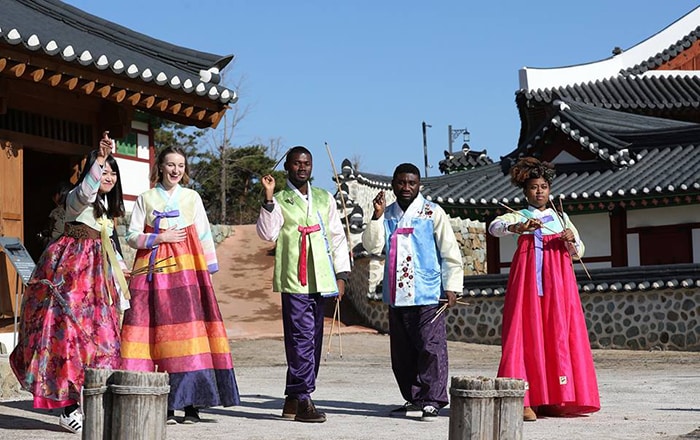
The Korea.net Honorary Reporters, clad in traditional Hanbok garments of various colors, enjoy a round of tuho, a traditional arrow-throwing game, on Dec. 27 at the ’12 gongbang,’ craftsmen’s workshops, located next to Sebyeonggwan Hall in Tongyeong. The workshops used to manufacture all kinds of military supplies and daily craftwork during Joseon times.
“We are all dressed in Hanbok and walk around this old building which embraces the nation’s traditional beauty and history. It feels like we are ‘blended into Korean culture, a culture totally different from ours,” said Williams Kyei from Ghana. “I feel like I am on a time capsule traveling back into the past,” said Elena Kubitzki with a big smile. Elena is a German college student who currently studies Korean language and literature at Myongji University. “It’s a really good idea to come here in Hanbok.”
Next to the Sebyeonggwan building was the so-called 12 gongbang (12공방), a series of craftsmen’s workshops from Joseon times where all types of military supplies and, also, daily craftworks, like traditional gat (갓) hats, folding fans and pieces inlaid with mother-of-pearl, were manufactured. Admiral Yi Sun-shin ordered the neighborhood of workshops to be built, so as to self-supply military materials to his naval forces. Since then, artisans from across the nation began to flock to the workshops. The number “12” in the 12 gongbang does not mean that there were 12 workshops. Instead, it’s a symbolic number which means the neighborhood was home to “a number of workshops.” Although only some of the workshops remain intact, the traditions of craftsmanship here have been handed down for more than 40 decades. With time-honored history, any craftwork that comes with the tag of “Tongyeong,” such as “Tongyeong Gat,” “Tongyeong Mother-of-Pearl Craftwork,” and “Tongyeong Folding Fan,” is considered as being of the greatest quality.
“This is a place where you can feel Korean history,” said Leonardo Ferreira, a Brazilian honorary reporter who majors in electrical and computer engineering at Seoul National University. “I realized how different the lives of Korean ancestors were in comparison to the Korean people of today. Through this experience, I’ve become more curious about the ancient lifestyle of the nation.”
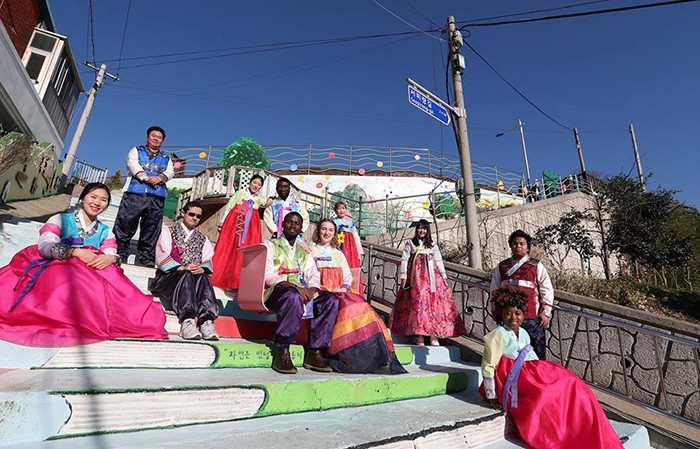
On Dec. 27, the Korea.net Honorary Reporters visit the Seopirang village and pose for a group photo on the 99-step stairway, one of the famous photo zones in the neighborhood, as part of their journey in Tongyeong, Gyeongsangnam-do Province.
The group then travelled to Seopirang (서피랑), a small village about one kilometer to the west of Sebyeonggwan Hall. Meaning, “The Western Cliff of Tongyeong,” the Seopirang neighborhood is well-known for wall paintings and sculptures of various colors and shapes that emerge as one strolls down the streets. The works of art can be enjoyed in a serene and leisurely atmosphere, compared to the crowded Dongpirang Wall Painting Village (동피랑 벽화마을), one of the busiest tourist attractions. The honorary reporters, too, found themselves taking selfies at some of the best locations for photo taking, such as the 99-step stairway which was painted in a way that makes it look like a pile of books, and sculptures of buttocks.
After a ten-minute ride by bus, they arrived at a grand concert hall and heard a piece of music coming from a speaker. It turned out to be a masterpiece by composer Yun Isang (1917-1995). The Tongyeong International Music Concert Hall welcomed the inquisitive visitors with the playing of the great composer’s music. The concert hall boasts a capacity of about 1,300 and hosts the well-known “Tongyeong International Music Festival,” an annual festival dedicated to the late composer. This year’s festival is set for March 31 until April 9, next year.
Yun grew up in Tongyeong and left behind the greatest-ever masterpieces in Korean music history. The musician studied in Japan, France and Germany and built his musical career across Europe. He’s remembered as a musician who bridged the music of the East and West by combining performing techniques in Korean music with Western musical instruments.
“This concert hall is awesome,” said Dominic Kankan from Ghana, a student of sport management at Seoul National University. “I love the wooden design and the oceanic view outside the windows, in particular. I can’t believe that such a small city as Tongyeong has invested such a lot amount of money in building and managing a concert hall of this scale. My country, Ghana, only major cities have this kind of musical facility. I’m quite impressed that this small city houses this magnificent concert hall.”

A group of 11 Korea.net Honorary Reporters stroll down the Undersea Tunnel (해저터널), the first submarine tunnel in Asia, as part of their journey in Tongyeong on Dec 27. The 483-meter tunnel was wholly constructed under a body of water in 1932.

A group of 11 Korea.net Honorary Reporters have fun posing for photos on the stage at the Tongyeong International Music Concert Hall in Tongyeong on Dec. 27.
The next morning, Dec. 28, the honorary reporters went on another adventure to uncover more treasures that they had yet to discover. They jumped on a ferry, heading for Jangsado Island (장사도), a small island off the southern waters in Maejuk-ri, Hansan-myeon. The island got its name, 장사도(長蛇島), because it resembles a long snake.
After one hour voyage, the adventurers soon found themselves surrounded by greenery. Located at the southern tip of the Korean Peninsula, the island enjoys mild weather almost all year long. That’s why the island is green throughout the year. Interestingly, almost 90 percent of trees, approximately 100,000 trees, are camellia. For that reason, this island is also called, “Camellia Island.” In early spring, in particular, the island turns red, creating a magnificent spectacle, as camellia flowers are in full bloom.
From the top of the island, you can enjoy a panoramic view of the nearby treasure islands on the south coast, including Sodeokdo, Somaemuldo, Gukdo and Sojido Islands. The stunning scenery of the neighboring islands against the blue sea makes Jangsado Island the perfect site for filming. In fact, popular soap operas have been set on this island, including the smash-hit SBS drama series “My Love From the Star” and “Uncontrollably Fond,” aired on KBS.
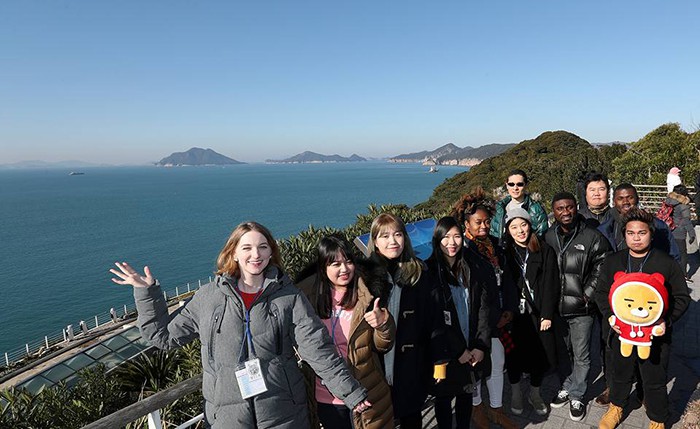
Korea.net honorary reporters pose for a commemorative photo on Jangsado Island, a small island about one hour away from Tongyeong Port, on Dec. 28.
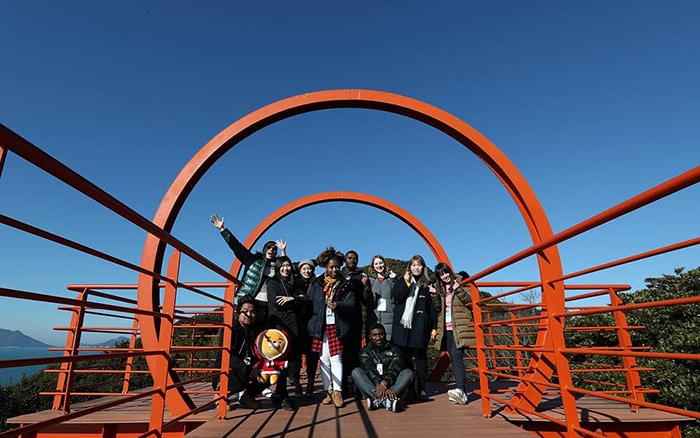
Korea.net honorary reporters have fun posing for a group photo on the Rainbow Bridge, one of the famous filming locations on Jangsado Island for Korea’s popular soap operas, on Dec. 28.
“The vast sea under the blue sky is totally breathtaking,” said Celeste David from the Philippines, a student who studies English literature at Myongji University. “I saw both ‘My Love From the Star’ and ‘Uncontrollably Fond’ filmed here on the island. It’s really cool to see in person the Rainbow Bridge that I saw in these dramas. I am so sorry, though, to not be able to see the camellia flowers in full bloom as in the dramas. I will come back for sure by the time all the flowers have bloomed.”
Williams Kyei, a Ghanaian honorary reporter, too, looked amazed as he said, “I uploaded the photos I took here in real time on my Instagram and immediately got responses from my friends, who are big fans of the Korean drama series. They were all jealous about me being here in the filming locations they really loved to see their favorite actors and actresses in. I will definitely recommend to newlyweds or couples around me that they should come here. During my time in Tongyeong, I’ve gained memorable moments that I will never forget.”
By Sohn JiAe, reporting from Tongyeong
Korea.net Staff Writer
Photos: Jeon Han Korea.net Photographer
jiae5853@korea.kr























